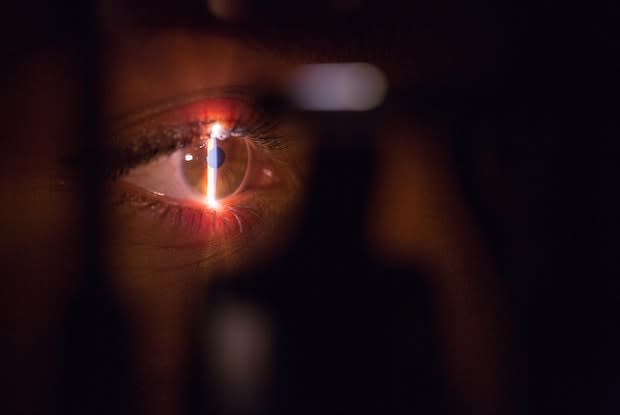Table of Contents
VI. Eye Drops and Laser Surgery
The Silent Thief of Sight
Glaucoma is an eye disease that can cause permanent vision loss. For reasons no one quite understands, glaucoma-affected eyes do not drain fluid as well as they should. Typically, the eye continuously creates and drains the fluid through a sponge-like structure called the trabecular meshwork. When glaucoma occurs, this drainage system does not function properly, and eye pressure begins to increase. Glaucoma is sometimes called the silent thief of sight because of the lack of symptoms in its most common forms (open-angle glaucoma). Because it has little to no symptoms, the damage can be severe by the time it is diagnosed. [1]
This progressive eye disease is often undetectable if you do not receive frequent eye exams. If your doctor suspects glaucoma, they will typically measure your intraocular pressure and check the optic nerve's health. When the optic nerve is pushed upon, it can cause vision changes and blindness.
There is no cure for glaucoma, but there are several things a person can do to prevent or slow down glaucoma progression. Eye drops like Lumigan are used frequently, but there many other things you can do yourself to keep your eyes healthy. Read on to learn more about tips to improve your glaucoma. [2]
Regardless of your age, it is important to have your eyes examined regularly. People often seek the help of an eye doctor if they feel their vision is changing, but sometimes it’s not as simple as a new glasses’ prescription. If you are over the age of 40, have a family history of glaucoma, high blood pressure, or diabetes, you are at a higher risk of developing glaucoma. You and your doctor can determine how many times a year an eye exam is needed. A glaucoma exam includes several tests which include: Tonometry: This test measures the pressure within the eye. The eye is numbed with drops. Then, a small amount of pressure is applied to the eyeball to measure the pressure. Ophthalmoscopy: The optic nerve is examined in this test to check for glaucoma damage. Eye drops dilate the pupil so the doctor can examine the color and shape of the optic nerve. If the nerve looks unusual, the doctor will perform a perimetry and gonioscopy test. Perimetry: Perimetry is a visual field test that produces a map of your field of vision. You will be asked to look straight ahead as spots of light are presented in your peripheral vision. This test may be repeated several times to see if your field of vision is damaged. Gonioscopy: This test measures the angle at which the iris meets the cornea. The eye is numbed with drops, and a hand-held contact lens is placed on the eye. A gonioscopy determines if this angle is open and wide or narrow—narrow-angle results in an increase of eye pressure. Pachymetry: This quick and simple test is used to measure the thickness of the cornea. A pachymeter (a wand-like device) is placed on the front of the eye and measures the thickness. This measurement can help determine intraocular pressure. [3] Some forms of glaucoma can occur due to injuries or trauma to the eye. Younger people are more likely to experience ocular injuries. Traumatic glaucoma can occur due to blunt trauma to the eye, which can occur while playing sports or other physical activities. If the eye is injured, the drainage mechanisms of the eye can be affected and lead to a pooling of blood inside the anterior chamber of the eye. This pooling of blood can lead to an increase in eye pressure, and glaucoma may occur. Symptoms of traumatic glaucoma can include: This type of glaucoma may not have constant symptoms, but it is important to seek an eye doctor's help even if the symptoms subside. Some patients may be asymptomatic until the vision loss is in advanced stages. It is essential to wear goggles during certain activities and exert caution when necessary. [4] When researching exercise and glaucoma, conflicting results are found. Some ophthalmologists encourage exercise with glaucoma, while others advise limiting certain activities because they may increase eye pressure. The fact that aerobic exercise is beneficial to your overall health cannot be argued. A study done in the American Academy of Ophthalmology studied the effect of 45 minutes of aerobic exercise three to four times a week. The results found that walking, swimming, and biking three days a week lowered intraocular pressure and increased healthy blood flow to the eye. [5] These studies show that cardio exercises can help with optic nerve health, but it is important to talk to your doctor to discuss what exercises are safe. Yoga is another exercise that can be done with caution. It is essential to avoid inverting the head to prevent increased pressure, so you may have to avoid certain positions like downward-facing dog and headstands. Heavy weight-lifting should also be avoided if you are at risk for glaucoma. This exertion may also increase your eye pressure. [5] Many people have been told that marijuana can act as a suitable treatment method for glaucoma. The goal of glaucoma treatment is to reduce eye pressure, and marijuana is often used because it can lower intraocular pressure. While the drug can lower pressure, it only lasts for around 3 to 4 hours. It has a short duration of action, so you would have to smoke marijuana 6-8 times a day to experience around the clock results. It is not sustainable to consume marijuana frequently in the case of glaucoma. Marijuana also has mood-altering effects, which can prevent people from operating heavy machinery or driving. A person can also be prescribed THC (tetrahydrocannabinol) droplets under the tongue in certain states, but this also results in feelings of drowsiness. All in all, the recreational use of marijuana is different from a medical treatment method. One study followed glaucoma patients who took THC or smoked marijuana for their glaucoma symptoms over nine months. At the end of the nine months, it was found that none of the participants continued the exclusive use of marijuana for their glaucoma because of the side effects. Prolonged marijuana use for glaucoma may also be dangerous because it lowers blood pressure. Lowered blood pressure can result in less blood flow to the optic nerve in the eye, which can worsen the nerve’s condition. [6] Along with the above techniques, eye drops to lower intraocular pressure are frequently prescribed. Lumigan eye drops work to regulate the flow of fluid within the eye to maintain normal eye pressure. These drops typically become a part of your daily routine and will likely have to be used for the rest of your life. [7] If the drops do not stop the progression of glaucoma, then laser surgery may be recommended. There are two main types of surgery that do not require a hospital stay. The first type, open-angle, involves using a laser to create more space for the fluid to drain through the eye. If you have angle-closure glaucoma, then the doctor will make tiny holes in the iris to help the fluid drain. [8] The content in this article is intended for informational purposes only. This website does not provide medical advice. In all circumstances, you should always seek the advice of your physician and/or other qualified health professionals(s) for drug, medical condition, or treatment advice. The content provided on this website is not a substitute for professional medical advice, diagnosis or treatment.
Get Regular Eye Exams
Protect Your Eyes

Exercise
Avoid Marijuana

Eye Drops and Laser Surgery
